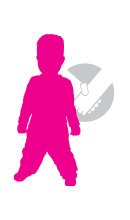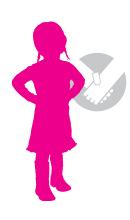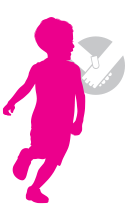Component 3: Emotional Recognition and Regulation
Standard 3.a: Children develop the ability to identify, express, and manage their emotions
By the following age ranges, children typically, for example:
- Demonstrate the ability to self-soothe (calm down) through behaviors such as babbling, thumb/fist sucking, or rocking
- Calm down when talked to, held, or rocked by a preferred caregiver
- Express a range of emotions (e.g., joy, excitement, or sadness) through facial expressions, gestures, signs, and/or sound

- Self-soothe when offered a special toy or blanket in combination with caregiver nurturance
- Look to a trusted adult for comfort when upset or stressed
- Demonstrate joy, pleasure, and excitement in learning to do new things

- Accept a security toy or blanket to self-soothe
- Demonstrate familiarity with routines
- Demonstrate strong emotions, such as anger, through actions (e.g., falling down on the floor and kicking their legs— throwing a “tantrum”) and calm down with caregiver assistance
- Express emotions (e.g., happiness, sadness, or anger) through singing and pretend play (in addition to “tantrums”)

- Calm themselves down after a temper tantrum in a reasonable amount of time with caregiver assistance
- Comfort themselves by seeking out a special toy, object, or caregiver
- Use words to express their emotions

- Are increasingly able to regulate their impulses in certain situations (e.g., waiting their turn for a favored toy)
- Can express emotions using words, signs, or other communication methods
- Take pride in their accomplishments
- Continue to use physical ways of expressing themselves when their feelings are intense (e.g., throwing things, pounding)

- React appropriately to strong emotions most of the time
- Persist at a difficult task with decreasing amounts of frustration
- Can name emotions using words, signs, or other communication methods

Standard 3.b: Children develop the ability to manage impulses and express emotions appropriately even in challenging situations.
By the following age ranges, children typically, for example:
- Exhibit the ability to wait for a desired object or person

- Amuse themselves for a short period of time
- Respond to verbal requests to alter their behavior, sometimes continuing with the behavior and sometimes accepting the redirection
- Say “no” to express their unwillingness (or sign “no” if they have been taught to sign)

- Respond to redirection most of the time
- Once redirected, change focus to the new object, person, or play
- Participate in routines with adult guidance

- Follow simple rules most of the time
- Control impulses (e.g., walking around—rather than through—a puddle when directed)
- Adapt their behavior to the environment (e.g., shifting from an “outside voice” to an “inside voice”)
- Adjust to changes in daily routines with preparation and adult assistance

- Usually follow rules and expectations in familiar settings
- Adjust to changes in routines and activities
- Ask or wait for adult permission before doing something they are unsure about
- Use materials with purpose, safety, and respect
- Can delay having desires met (e.g., agreeing to the use of a timer to indicate their turn for a computer)
- Stop an engaging activity to transition to another less desirable activity with adult guidance and support

- With adult assistance, demonstrate control over actions, words, and emotions in response to a situation
- Follow rules and apply them to new situations and environments (e.g., putting their coat in a cubby at school but hanging it on a peg at home)
- Participate in group activities for increasing amounts of time
- Consistently demonstrate the ability to stop an engaging activity to transition to another less desirable activity

